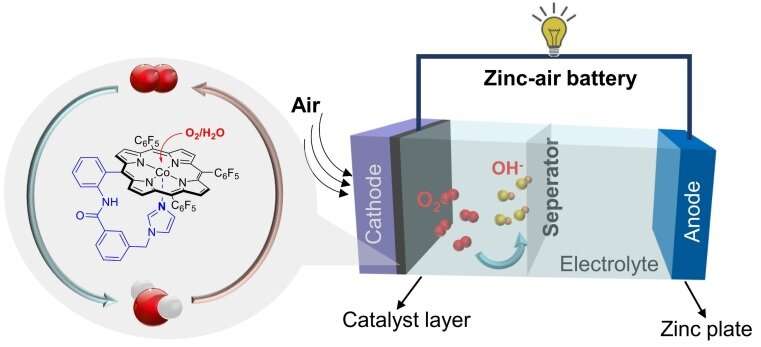This article has been reviewed according to Science X's editorial process and policies. Editors have highlighted the following attributes while ensuring the content's credibility:
fact-checked
trusted source
proofread
Cobalt(II) porphyrin with a tethered imidazole for efficient oxygen reduction and evolution electrocatalysis

Electrocatalytic oxygen reduction and evolution reactions occur in various fuel cells, metal-air batteries, and in water splitting devices. Large-scale use of noble metals and their complexes in industries are limited by their low abundance and high cost.
Recently, several first-row transition metal complexes have been identified as active electrocatalysts for the oxygen reduction reaction (ORR) and oxygen evolution reaction (OER). Nevertheless, only a few catalysts are efficient for both ORR and OER under identical conditions, which is crucial for use in rechargeable metal-air batteries.
Co porphyrins have been largely studied as catalysts for O2 reduction. In addition to ORR, Co porphyrins have been shown to be efficient electrocatalysts for OER. Despite these achievements, however, developing Co porphyrins with high activity and stability for both electrocatalytic oxygen reduction and evolution reactions under the same conditions is still required.
Recently Rui Cao and Weiqiang Zhang of Shaanxi Normal University, Shunichi Fukuzumi and Wonwoo Nam of Ewha Womans University and others published a letter titled "A cobalt(II) porphyrin with a tethered imidazole for efficient oxygen reduction and evolution electrocatalysis" in the Journal of Energy Chemistry.
In cytochrome c oxidases (CcOs), Fe porphyrins with an axial histidine imidazole group catalyze the selective reduction of O2 to water. The axial imidazole group can increase the electron density of Fe, and thus improve O2 binding and activation at the Fe center through an electronic "push effect".
Inspired by nature, the authors report Co porphyrin 1 with an imidazole group appended to the porphyrin backbone for Co axial binding as an active bifunctional electrocatalyst for oxygen reduction and evolution reactions. In addition, 1 was used as a catalyst in air electrodes for Zn-air batteries. The resulting Zn-air battery exhibited comparable performance to batteries made using commercial Pt/C and Ir/C materials.
This work is significant as it highlights the important role of axial ligands in enhancing ORR and OER and shows the potential applications of molecular catalysts in electrocatalysis-based energy conversion and storage technologies.
More information: Xialiang Li et al, A cobalt(II) porphyrin with a tethered imidazole for efficient oxygen reduction and evolution electrocatalysis, Journal of Energy Chemistry (2022). DOI: 10.1016/j.jechem.2022.10.010
Provided by Chinese Academy of Sciences





















